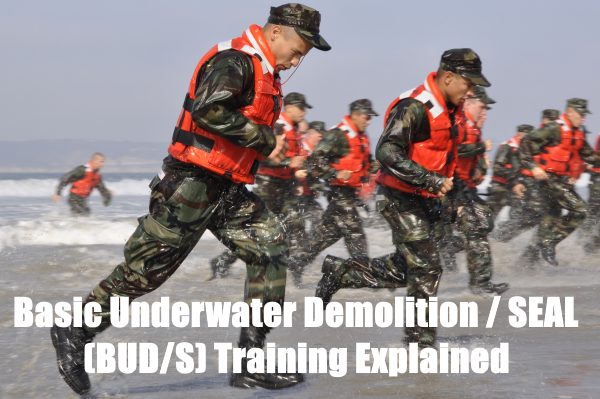The U.S. Navy’s primary special operations force is SEALs.
Navy Sea, Air, Land Teams (SEALs) have a notorious reputation for undergoing some of the most intense basic training of any military unit in the world.
In fact, the average member of the U.S. Navy SEALs spends over a year with initial training.
And that’s just the start.
You can expect to spend 2.5 years of training before you can even deploy for your first time.
Basic Underwater Demolition/SEAL (BUD/S) is the first step in a series of training environments the U.S. Navy uses to prepare these elite commandos.
So, what can you expect at Navy SEAL Training?
Continue reading to learn more about BUD/S, along with an introduction to Parachute School and SEAL Qualification Training (SQT).
Jump To A Section
Navy SEAL Training Basic Requirements
Navy SEAL Training Snapshot
NSW Prep School
BUD/S Orientation
1st Phase
2nd Phase
3rd Phase
Final Stage & Graduation
Parachute Jump School
Frequently Asked Questions (FAQ)
Navy SEAL Training Basic Requirements
Before you can even attend Navy SEAL Training, you need to meet some basic physical and mental requirements.
These involve the following:
- Pre-enlistment medical screening (i.e. MEPS)
- Take the ASVAB Test
- Take the C-SORT Test
- Pass the Physical Screening Test (PST)
Let’s examine each one of these briefly so you know exactly what to expect.
Pre-Enlistment Medical Screening (MEPS)
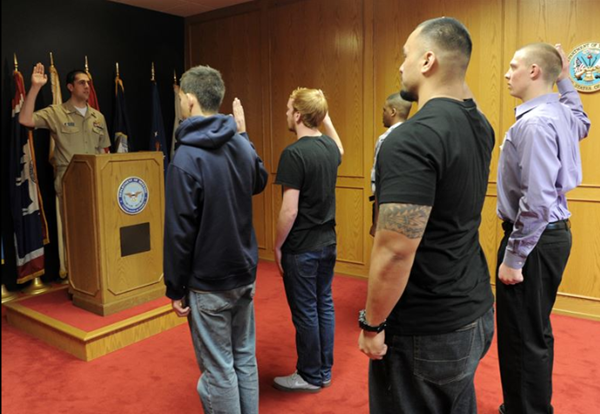
All future Navy sailors, regardless of what job they’ll be doing, will go through a Military Entrance Processing Station exam (aka MEPS).
MEPS is a roughly 2-day process that involves a stringent physical and mental examination.
At MEPS, they test for everything, including:
- Blood pressure, Pulse, and Temperature
- Hearing and Vision
- Height, Weight, and BMI
- Drug Testing
- Orthopedic / Neurological testing
- Behavioral Health
- An examination of your body from top to bottom
- Medical history interview
Assuming everything checks out, MEPS is also the place where you’ll be sworn in.
Lastly, it’s also the place that you will take the ASVAB test, assuming you haven’t already taken it before attending MEPS.
ASVAB Test
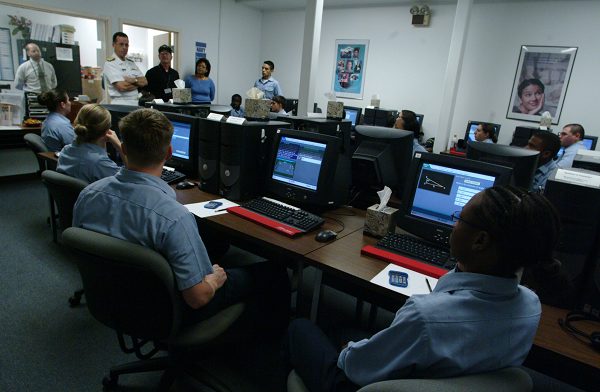
The Armed Services Vocational Aptitude Battery, or ASVAB, is a test that all those looking to join the military must take.
The ASVAB is designed to measure your knowledge and ability in 10 different areas, and is used to allow the Navy to determine which jobs you qualify for.
In order to qualify to enter Navy SEAL training, you need to have the following minimum ASVAB test scores:
- VE + MK + MC + CS = 220 or greater
- GS + MC + EI = 170 or greater
- VE + AR = 110 or greater
- MC = 50 or greater
After completing the ASVAB test, you’ll then take the Computerized-Special Operations Resiliency Test, otherwise known as C-SORT.
Related Article – 12 ASVAB Tips and Tricks To Help You Get The Best Score
C-SORT Test
The Computerized-Special Operations Resiliency Test (C-SORT), is a test that is used to determine maturity and mental resilience in Naval Special Warfare candidates.
This is important because, when it comes to Navy SEAL training, it’s all about mental toughness.
If you’re not mentally tough, you will simply not successfully complete the training. Period.
Unfortunately, there aren’t any study guides available for the C-SORT test.
With that said, you can prepare for it by working hard to get the best scores possible on the Physical Screening Test, or PST.
Physical Screening Test (PST)
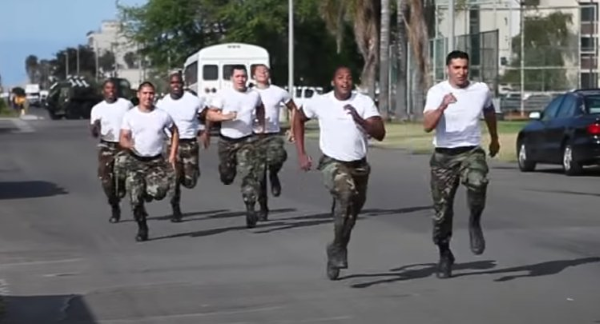
The Physical Screening Test, or PST, is a physical test that is used to assess a SEAL training candidates physical ability.
It’s divided up into the following events:
- 500 Yard Swim
- Pushups
- Sit-Ups
- Pull-Ups
- 1.5 Mile Run
When compared to Navy SEAL training, the test is relatively easy. You will be expected to perform way harder should you ever make it to the shores of Coronado.
Here’s a quick snapshot of the minimum and optimum PST scores for both enlisted and officer candidates:
PST Scores For Enlisted
| Event | Minimum | Competitive |
|---|---|---|
| 500 Yard Swim - Side / Breast Stroke | 12:30 | 9:30 or better |
| Push Ups | 50 | 75+ |
| Curl Ups | 50 | 75+ |
| Pull Ups | 10 | 15+ |
| 1.5 Mile Run | 10:30 | 9:30 or better |
PST Scores For Officers
| Event | Minimum | Competitive |
|---|---|---|
| 500 Yard Swim - Side / Breast Stroke | 12:30 | 9:00 |
| Push Ups | 50 | 85 |
| Curl Ups | 50 | 85 |
| Pull Ups | 10 | 20 |
| 1.5 Mile Run | 10:30 | 9:00 |
Once you successfully complete all of the above, you’ll then move onto the process of entering Navy SEAL training.
Navy SEAL Training: A Snapshot
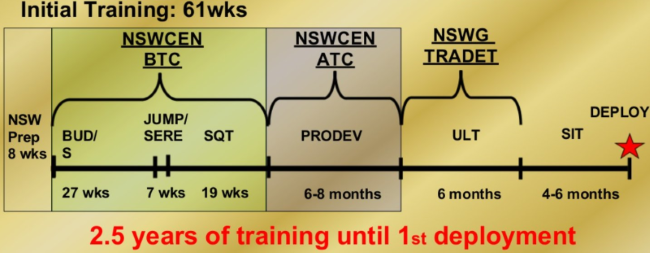
As mentioned earlier, the SEAL training pipeline is 61 total weeks in duration.
It can roughly be broken down as follows:
- Navy Special Warfare (NSW) Prep Course – 8 Weeks (max 12 Weeks)
- BUD/S Orientation – 3 Weeks
- Basic Underwater Demolition / SEAL Training (BUD/S) – 27 Weeks
- Navy Parachute Course – 4 Weeks
- NSW SERE Level C – 10 Days
- Seal Qualification Training (SQT) – 19 Weeks
The philosophy behind this training is a ‘crawl, walk, run’ style, meaning you’ll start everything off slowly, and the training gradually gets ramped up in intensity
Let’s dive in to the nitty gritty details for each step in the training cycle.
Related Article – How To Check If Someone Was A Navy SEAL
NSW Prep School
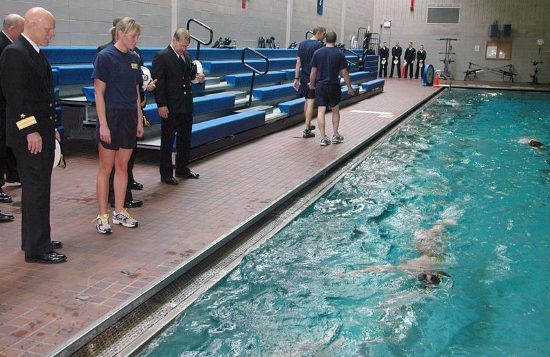
The Navy Basic Underwater Demolition/SEAL (BUD/S) School is open to males and females.
It’s a voluntary offering as both enlisted personnel and officers seek the designation of Navy SEAL.
Therefore, both types of personnel train side by side during basic SEAL training.
The U.S. Navy has several requirements you need to qualify for the training program.
The Naval Special Warfare Preparatory School introduces students to what it takes to become a Navy SEAL.
The NSW prep school lasts eight weeks and takes place in Great Lakes, Illinois.
Students receive a crash course on the physical fitness standards needed to excel as an elite operative.
Recruits need to exceed the minimum requirements of the SEAL Physical Screening Test (PST).
Once students near the completion of NSW prep school they have to pass the more demanding Modified Physical Screening Test.
The modified version includes needing to complete a 4-mile run in less than 31 minutes as well as a timed 1,000 meter swim with fins in 20 minutes.
The purpose of the Naval Special Warfare Preparatory School is to make the training slightly easier at BUD/S.
Consequently, students can expect to reach the pinnacle of their fitness through the preparation exercises and fitness tests.
Those that are unable to pass the final modified PST test no longer qualify for SEAL training and return to another job within the U.S. Navy.
You can do yourself a favor by starting to train for the Naval Special Warfare Preparatory School in advance.
Related Article – US Navy SEAL Rank Structure, Insignia, and Pay
BUD/S Orientation
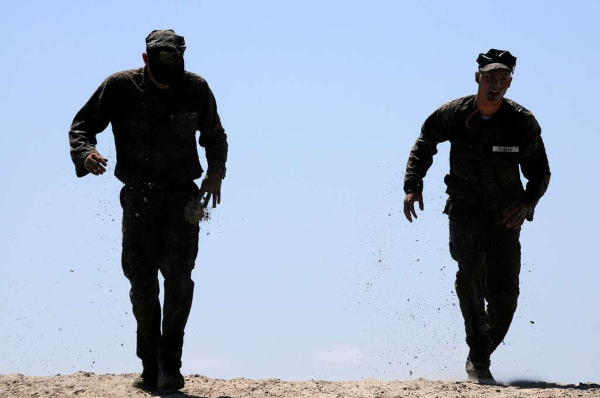
The U.S. Navy Basic Underwater Demolition/SEAL (BUD/S) School takes approximately a half year to complete.
It’s the first of many steps of training you need to receive the official rating of a Navy SEAL in the military branch.
BUD/S training introduces recruits to the physical fitness requirements and mental strength needed to succeed as a SEAL.
Additionally, it helps develop your leadership skills which are another important attribute of Navy SEALs.
Recruits start their journey at Navy BUD/S Orientation.
The orientation segment of BUD/S training is short and lasts a few weeks.
Students learn more about the Naval Special Warfare Center and what they can expect at BUD/S.
Navy SEAL instructors introduce students to fitness training like swimming and completing the obstacle course.
The goal is to focus on the exercises you struggle the most with so you’ll be in better shape once you reach 1st Phase of BUD/S.
Each phase of BUD/S training includes a timed physical fitness test.
The requirements for passing the test become more intense as you progress through the phases of training.
Therefore, students focus on individual accomplishments while also learning how to work together as a team.
Related Article – Navy Special Warfare Operator (SO) AKA Navy SEAL: Career Profile
1st Phase
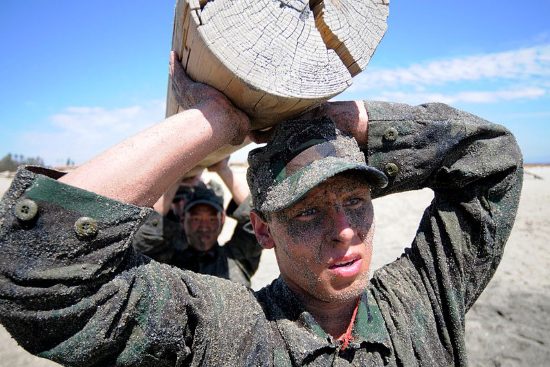
After students get through the first few weeks of orientation they transition into phase one of the Basic Underwater Demolition/SEAL (BUD/S) School.
The first phase of BUD/S takes approximately 7 weeks to complete.
The primary focus of 1st phase is to get you physically ready for the added challenges of being a SEAL.
For this reason, expect a daily workout regime that is going to be a severe wake-up call.
The physical conditioning includes running, calisthenics, and swimming.
Every week, Sailors must complete 4-mile timed runs in boots along with an obstacle course.
Secondly, recruits conduct open ocean swims in distances of up to 2 miles wearing fins.
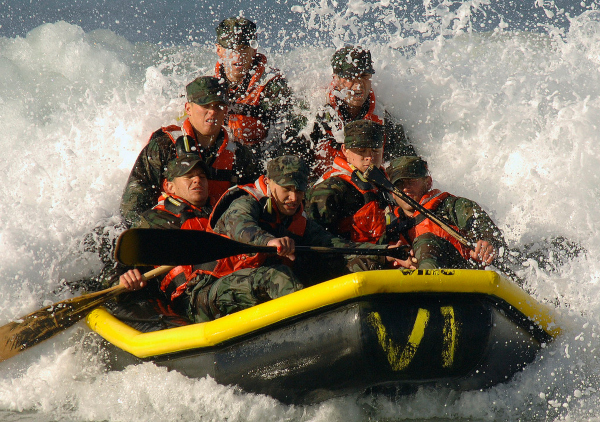
The demands get harder every week you progress which makes BUD/S such an exhausting training environment.
It’s one of the reasons why their motto is ‘The Only Easy Day Was Yesterday”.
The first several weeks of 1st Phase prepare recruits for “Hell Week”.
“Hell Week” takes place around the fourth week of BUD/S training.
During this grueling week, recruits participate in 5 1/2 days of continuous training.
The maximum break you get during “Hell Week” is four hours to sleep which is where a lot of candidates drop out.
The video below is a fairly good snapshot of what Hell Week is like:
“Hell Week” is intended to serve as the ultimate survival test to see who truly has what it takes to become a Navy SEAL.
While it might sound like unnecessary torture, there is a method to the madness.
“Hell Week” teaches the values of perseverance, hard work, dedication, and teamwork.
The latter of which is incredibly important for all Navy SEALs.
It’s also designed to weed out the students who really don’t want to be there, but don’t realize it yet.
If you get through “Hell Week” you’ll get a short reprieve as you focus on classroom learning.
Nicknamed ‘Walk Week’ because you’re no longer required to run everywhere you go, it introduces candidates to the various methods of conducting hydrographic surveys and charts.
Related Article – Navy SEAL Creed / Ethos / Motto
2nd Phase
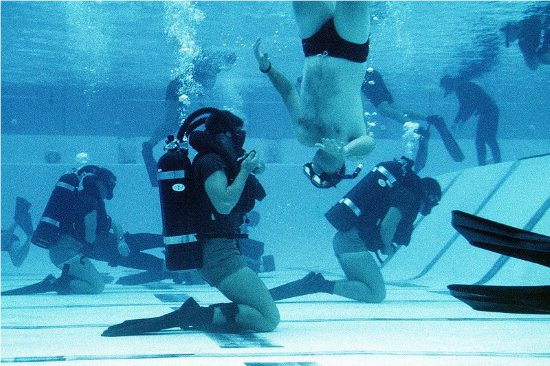
You can take a deep breath after completing 1st phase of training; however, you still have two more phases to go before BUD/S training is complete.
Some even believe 2nd phase is actually harder than 1st phase!
2nd Phase of Navy Basic Underwater Demolition/SEAL (BUD/S) School is primarily related to combat diving.
Combat diving is critical to Navy SEAL operations and requires you to become a master swimmer and diver.
While physical fitness training continues during 2nd phase (in order not to lose the progress you’ve made), it’s not quite as physically intense.
Instead, the phase concentrates on combat SCUBA (Self Contained Underwater Breathing Apparatus).
Navy SEALs learn two types of SCUBA at BUD/S training:
- Open Circuit (Compressed Air) SCUBA
- Closed Circuit (100& Oxygen) SCUBA
BUD/S students will become intimately familiar with an underwater re-breather called the LAR-V Draeger.
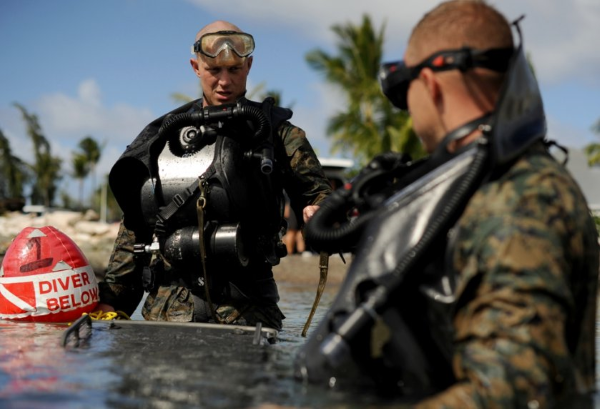
The Draeger is a closed-circuit diving apparatus that is used by special operations diving units around the world.
Unlike a typical open circuit diving rig, it works by recirculating the breathing gas already used by the diver and removing the carbon dioxide.
Its primary advantage is that it emits no bubbles, something that is extremely important for SEALs conducting covert underwater dives.
As previously mentioned, SEAL teams are expert divers and swimmers which is what separates them from other special operations forces.
Therefore, 2nd phase places an emphasis on long-distance underwater dives.
It also teaches students swimming and diving techniques to become more efficient in the water.
Often, Navy SEALs depart from a ship, dive, and swim to a combat objective.
Students test out of 2nd Phase by meeting running and swimming requirements.
The swimming requirements include the ability to complete a timed 2-mile swim, along with a 3.5-mile and 5.5-mile swim.
Those who successfully complete 2nd phase demonstrate a high level of comfort in the water and the ability to respond to stressful environments.
While it helps to physically prepare yourself for 2nd phase by swimming a lot, there have been plenty of BUD/S graduates who have never even seen the ocean in person prior to training.
Related Article – Navy SEAL Cadence: A List of the 10 Most Popular SEAL Running Cadences
3rd Phase
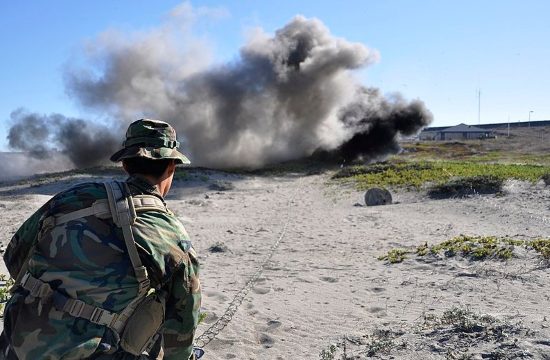
3rd Phase is the final stage in Navy Basic Underwater Demolition/SEAL (BUD/S) training.
The U.S. Navy refers to this phase as the demolitions, reconnaissance, and land warfare segment.
3rd Phase lasts about the same time as the first two stages as students prepare for parachute jump school.
Once again, physical fitness training continues as students prepare for the final Modified Physical Screening Test.
As a result, Navy SEAL candidates endure more strenuous runs and swims.
They also continue to face new challenges navigating through the obstacle course.
Meanwhile, 3rd Phase primarily focuses on land navigation, rappelling, patrolling, explosives, infantry tactics, and small-unit tactics.
It’s the point in BUD/S training where students finally see their hard work pay off and become masters of their craft.
Classroom instruction is very important as you learn to read a compass and map.
Additionally, students focus on basic weapon skill sets during this fast-paced learning phase.
Final Stage & Graduation
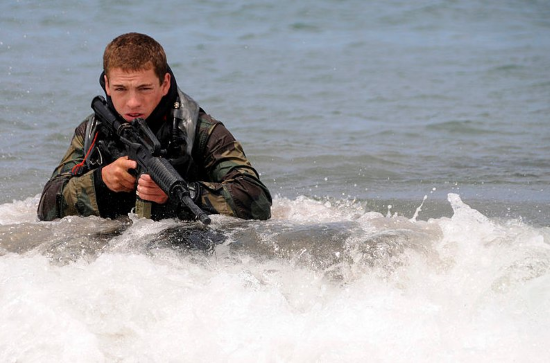
The second part of 3rd Phase moves the training location to San Clemente Island, which is close to San Diego, California.
Commonly referred to by students as “The Rock,” San Clemente Island serves as the final training ground for BUD/S.
Here, students put all their classroom learning to practice as they endure a realistic day in the life of a Navy SEAL.
The long hours and laborsome work are designed to provide an example of what a real day would resemble for a SEAL team.
While some candidates dread “Hell Week,” others argue that the final few weeks of BUD/S training are the hardest.
It’s easy to see why as the training lasts seven days a week with minimal sleep and instructors constantly shouting in your ear.
Additionally, recruits are handling live explosives and ammunition, which makes the portion of SEAL BUD/S training dangerous.
Lastly, students need to complete a final Modified Physical Screening Test (PST).
The U.S. Navy requires prospective SEALs to complete a timed 2-mile ocean swim with fins along with two long-distance runs (one with boots, one without).
Complete this physical fitness test and you have reason to celebrate; however, your training to become a Navy SEAL is far from complete.
Related Article – Navy SEALs vs. Marines: 4 Major Differences Between The 2
Parachute Jump School
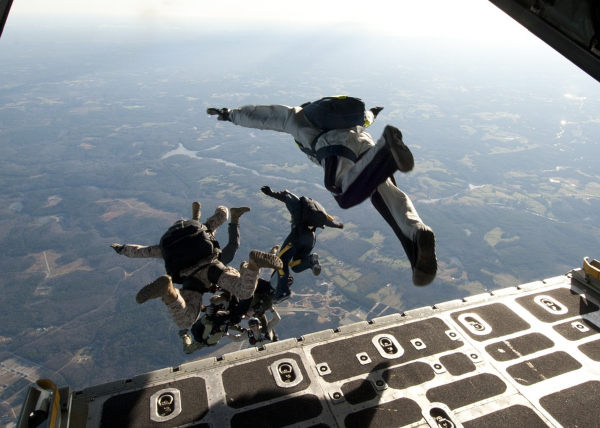
After candidates complete Navy Basic Underwater Demolition/SEAL (BUD/S) School they advance to Parachute Jump School.
Navy Parachute Jump School is much shorter and only lasts a few weeks.
Regardless, expect another challenging segment of Navy SEAL training as a lot of information is crammed into these few weeks.
Candidates receive their jump school training at the notorious Army Airborne School in Fort Benning, Georgia.
It’s the final step before they report to their first Naval Special Warfare Command and begin SEAL Qualification Training (SQT).
Additionally, students need to complete two weeks of Special Operations Technician Training to receive instruction on diving skills and medicine.
The Parachute Jump School provides training for static line and free-fall exercises.
The program is highly accelerated with world-class instructors and serves as a unique memory for every SEAL.
In order to graduate from the program, recruits need to complete a series of jump progressions.
The final descent takes place at night with combat equipment at a minimum altitude of 9,500 feet.
Frequently Asked Questions (FAQ)
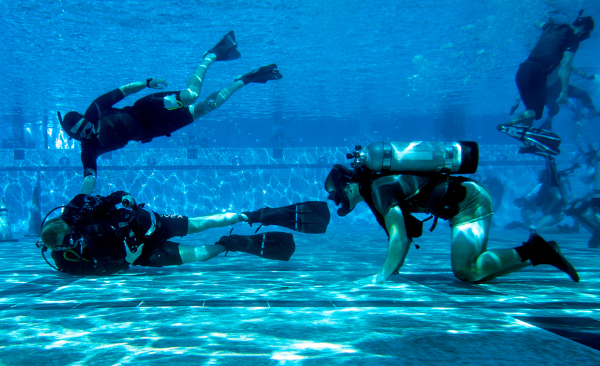
Do you have more questions about Navy BUD/S?
Here are some frequently asked questions about Basic Underwater Demolition/SEAL Training:
Related Article – Navy SEAL Weapons and Gear: 24 Rifles, Handguns, Shotguns, and More
How long is BUD/S?
The U.S. Navy Basic Underwater Demolition/SEAL (BUD/S) School lasts 23 weeks or approximately a half year.
Navy BUD/S training is divided into four segments:
- Orientation (2 weeks)
- 1st Phase (7 weeks)
- 2nd Phase (7 weeks)
- 3rd Phase (7 weeks)
There are additional requirements and training needed to become a U.S. Navy SEAL.
However, this completes the BUD/S portion of SEAL training.
How hard is BUD/S?
Navy BUD/S training is one of the most intense and challenging things you’ll ever encounter.
For starters, the training program is a test of endurance as it lasts about a half year with very few breaks.
During “Hell Week” and the final stage of BUD/S training, you get minimal rest while completing stressful exercises.
The physical fitness standards are extremely tough and the minimum requirements get more demanding as you progress through BUD/S.
In addition to the harsh physical demands, Navy BUD/S is also designed to test you mentally.
Consequently, you may feel like quitting from a mental standpoint before you reach the end of the 23 weeks.
The instructors are demanding and may treat you like an enemy yet it’s necessary to prepare you for a Special Operations Force (SOF).
Lastly, you’ll also obtain a lot of new information on everything from diving techniques to handling live explosives underwater.
There is an element of danger as some recruits have tragically perished during BUD/S training.
Do people die in BUD/S?
Yes, unfortunately, there are a few examples of recruits dying during Navy BUD/S training.
The most recent example that gained a lot of publicity was in February of 2022 when one recruit passed away after Hell Week.
While the United States Navy takes every precaution to avoid this from happening, the reality is SEAL training is extremely difficult.
There are a few sad stories of candidates losing consciousness in the water and losing their lives as a result.
Since a couple of reported tragedies in 2016, the U.S. Navy has reportedly taken steps to make BUD/S training a safer place.
Nonetheless, the risk of death remains a possibility for every new recruit to the program.
Related Article – Green Berets Vs. Navy SEALs
Do you get weekends off at BUD/S?
It depends on the phase of training.
The Navy BUD/S training program schedule is Monday through Friday during the 1st and 2nd Phases.
As a result, students get their weekends off to relax and recover.
On the other hand, training in the 3rd Phase is seven days a week, which means that recruits get close to no time off for the final two months of the program.
The point is to survive 3rd Phase and graduate from BUD/S and get some time off before you progress to Parachute Jump School and Navy SEAL Qualification Training (SQT).
Do you get paid during BUD/S?
Yes, the U.S. Navy pays you during all your training exercises as you prepare to become a SEAL team member.
Your pay is determined based on your military rank and years of service.
Recruits of the Navy Basic Underwater Demolition/SEAL (BUD/S) School are both enlisted personnel and officers.
Additionally, every recruit of BUD/S earns monthly dive pay and hazardous duty pay as added bonuses.
Finally, you may receive an enlistment bonus of several thousand dollars for completing BUD/S training. However, you’ll want to speak with a local Navy recruiter to confirm this offer.
Related Article – DEVGRU: 7 things you didn’t know about SEAL Team 6
What happens after BUD/S?
Recent BUD/S graduates advance to basic parachute training.
The jump school is accelerated and only takes a few weeks to complete.
Secondly, students need to complete the Special Operations Medical Sergeant Course.
Thirdly, recruits must complete SEAL Qualification Training (SQT).
Navy SQT training is just as long as BUD/S (26 weeks) and takes the student from a basic elementary understanding of Naval Special Warfare to an advanced understanding.
Students acquire advanced tactical training before they join a SEAL team.
Once students complete Navy SQT, they receive orders for their first assignment.
Then, new operatives focus on SEAL troop (TRP) training along with individual specialty training.
The traditional training of pre-deployment is usually 12-18 months.
As a result, most new Combat Swimmers have 2-3 years of their first enlistment to serve the Navy SEALs out in the field in either a SEAL Delivery (SDV) or SEAL team.
Those who choose to reenlist may have to complete additional training for another SDV or SEAL Command.
There are several advanced training courses available for Navy SEAL team members.
Related Article – 6 Best Navy SEAL Documentaries Of All Time
Conclusion
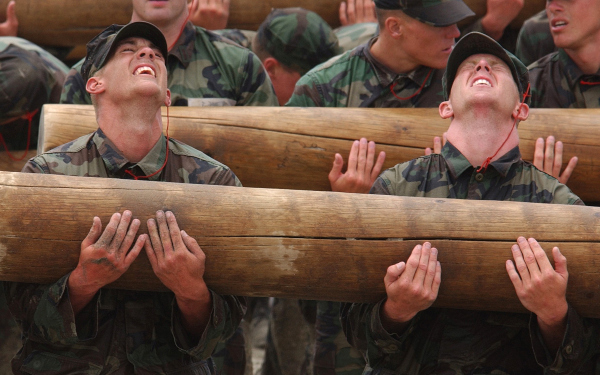
The Basic Underwater Demolition/SEAL (BUD/S) School is the introduction to life in the Navy SEALs.
Navy BUD/S training takes a half year to complete and is extremely challenging.
The training is necessary to prepare specialists for the demanding and dangerous challenges of a Navy SEAL.
Navy SEALs perform operations across the globe and are one of the most prestigious special operations forces in the world.
While not everyone is cut out to become a SEAL, if you are interested, you should consider preparing for BUD/S by getting into excellent physical fitness and preparing yourself mentally.
References
https://www.sealswcc.com/navy-seal-training-stages.html
- Navy Promotion Timeline for Enlisted & Officers - June 19, 2024
- Navy SEAL Training (BUD/S) - June 19, 2024
- Navy Aircraft Carrier Flight Deck Shirt Colors Explained - June 19, 2024

